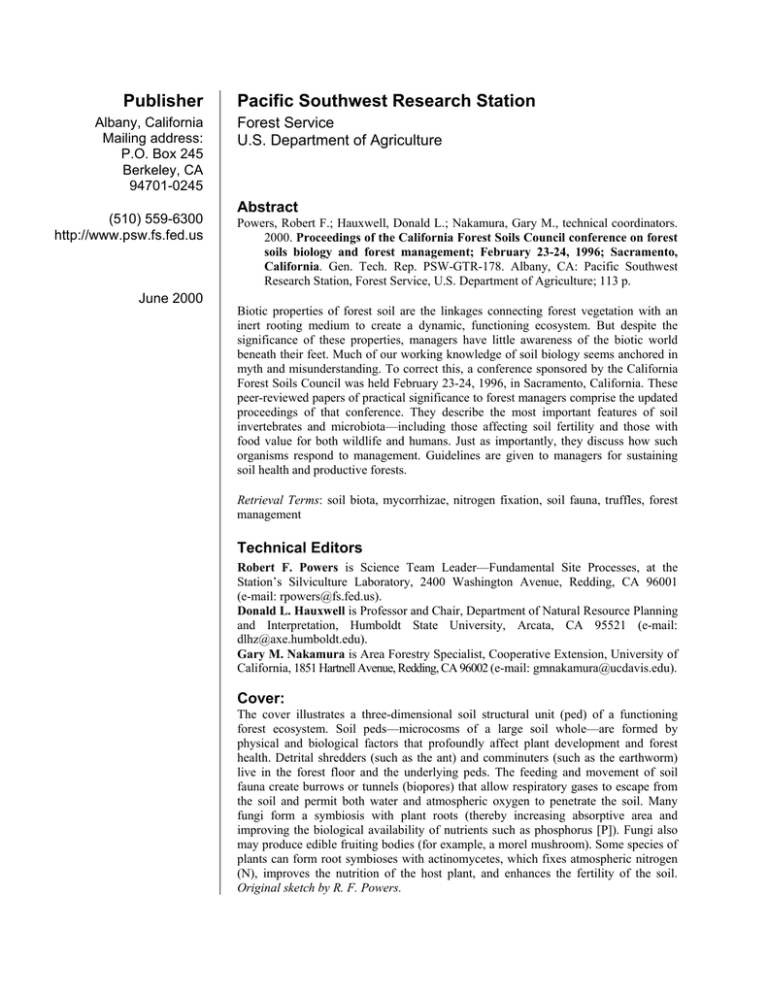Publisher Pacific Southwest Research Station Abstract
advertisement

Publisher Albany, California Mailing address: P.O. Box 245 Berkeley, CA 94701-0245 (510) 559-6300 http://www.psw.fs.fed.us June 2000 Pacific Southwest Research Station Forest Service U.S. Department of Agriculture Abstract Powers, Robert F.; Hauxwell, Donald L.; Nakamura, Gary M., technical coordinators. 2000. Proceedings of the California Forest Soils Council conference on forest soils biology and forest management; February 23-24, 1996; Sacramento, California. Gen. Tech. Rep. PSW-GTR-178. Albany, CA: Pacific Southwest Research Station, Forest Service, U.S. Department of Agriculture; 113 p. Biotic properties of forest soil are the linkages connecting forest vegetation with an inert rooting medium to create a dynamic, functioning ecosystem. But despite the significance of these properties, managers have little awareness of the biotic world beneath their feet. Much of our working knowledge of soil biology seems anchored in myth and misunderstanding. To correct this, a conference sponsored by the California Forest Soils Council was held February 23-24, 1996, in Sacramento, California. These peer-reviewed papers of practical significance to forest managers comprise the updated proceedings of that conference. They describe the most important features of soil invertebrates and microbiota—including those affecting soil fertility and those with food value for both wildlife and humans. Just as importantly, they discuss how such organisms respond to management. Guidelines are given to managers for sustaining soil health and productive forests. Retrieval Terms: soil biota, mycorrhizae, nitrogen fixation, soil fauna, truffles, forest management Technical Editors Robert F. Powers is Science Team Leader—Fundamental Site Processes, at the Station’s Silviculture Laboratory, 2400 Washington Avenue, Redding, CA 96001 (e-mail: rpowers@fs.fed.us). Donald L. Hauxwell is Professor and Chair, Department of Natural Resource Planning and Interpretation, Humboldt State University, Arcata, CA 95521 (e-mail: dlhz@axe.humboldt.edu). Gary M. Nakamura is Area Forestry Specialist, Cooperative Extension, University of California, 1851 Hartnell Avenue, Redding, CA 96002 (e-mail: gmnakamura@ucdavis.edu). Cover: The cover illustrates a three-dimensional soil structural unit (ped) of a functioning forest ecosystem. Soil peds—microcosms of a large soil whole—are formed by physical and biological factors that profoundly affect plant development and forest health. Detrital shredders (such as the ant) and comminuters (such as the earthworm) live in the forest floor and the underlying peds. The feeding and movement of soil fauna create burrows or tunnels (biopores) that allow respiratory gases to escape from the soil and permit both water and atmospheric oxygen to penetrate the soil. Many fungi form a symbiosis with plant roots (thereby increasing absorptive area and improving the biological availability of nutrients such as phosphorus [P]). Fungi also may produce edible fruiting bodies (for example, a morel mushroom). Some species of plants can form root symbioses with actinomycetes, which fixes atmospheric nitrogen (N), improves the nutrition of the host plant, and enhances the fertility of the soil. Original sketch by R. F. Powers.




